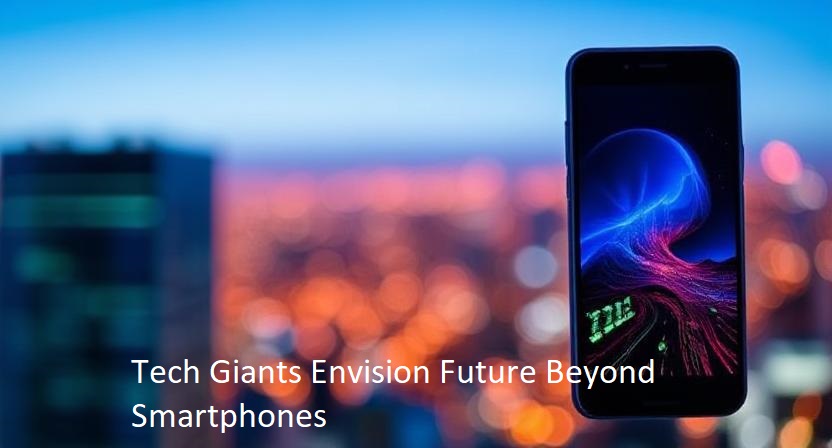Smartphones have been the centerpiece of innovation for more than a decade. They changed how people connect, shop, learn, and entertain themselves. However, the dominance of smartphones is slowly being challenged as tech giants envision future beyond smartphones. Industry leaders such as Apple, Google, Meta, Microsoft, and Samsung are heavily investing in new technologies that go beyond handheld devices. These advancements aim to shape the next generation of connectivity and redefine how humans interact with technology.
The Shift Beyond Smartphones
For years, smartphones symbolized the peak of personal technology. But today, consumer expectations are evolving, and companies recognize that people are looking for more immersive, seamless, and intelligent experiences.
Tech giants envision future beyond smartphones by focusing on devices and platforms that can blend into everyday life. Instead of being glued to a screen, the future will likely involve wearables, augmented reality (AR), virtual reality (VR), and artificial intelligence (AI)-driven ecosystems that operate in the background.
Why Move Beyond Smartphones?
-
Market Saturation: Nearly every adult owns a smartphone, making growth harder.
-
Consumer Demands: People want more intuitive and immersive tools.
-
Technological Advancements: AI, AR, VR, and IoT are becoming more practical.
-
Vision of Ubiquitous Computing: The future lies in seamless integration of tech into daily routines.
Key Areas of Innovation
The next era of digital transformation revolves around a few major areas where tech giants are channeling investments and research.
1. Wearable Technology
Wearables such as smartwatches, fitness bands, and smart glasses are already expanding the boundaries of what mobile devices can do. Apple’s success with the Apple Watch shows how health monitoring and convenience can become mainstream. In the future, wearables will not only track health but also become gateways to augmented reality and AI-powered services.
2. Augmented Reality (AR) and Virtual Reality (VR)
One of the strongest indicators that tech giants envision future beyond smartphones is the massive investment in AR and VR. Meta (formerly Facebook) has made the “Metaverse” its central mission, betting big on virtual worlds where people can work, play, and socialize. Similarly, Apple is preparing AR/VR headsets that promise to revolutionize entertainment, communication, and productivity.
These immersive devices will reduce dependency on flat screens and create experiences that feel more natural and engaging.
3. Artificial Intelligence and Voice Assistants
Smartphones are already using AI through features like Siri, Alexa, and Google Assistant. However, future innovations will shift AI into a standalone interface that doesn’t require a phone screen. Imagine controlling your home, car, or work environment through voice and gestures powered by advanced AI systems.
4. Internet of Things (IoT) and Smart Homes
Another way tech giants envision future beyond smartphones is through the Internet of Things. Smart speakers, connected appliances, and AI-driven home systems are turning households into connected ecosystems. In this model, smartphones are no longer the central hub; instead, the environment itself becomes “smart.”
5. Brain-Computer Interfaces (BCI)
Although still experimental, companies like Neuralink are exploring brain-computer interfaces that could bypass smartphones entirely. By directly linking human thoughts to digital systems, BCIs may represent the ultimate evolution in personal technology.
How Leading Tech Giants Are Preparing
To understand how the industry is moving, it’s important to see what the biggest companies are doing.
Apple
Apple continues to dominate the smartphone market, but its future vision clearly extends to AR. With patents and leaks pointing toward Apple Vision Pro and AR glasses, the company aims to transition users from screens to immersive digital experiences.
Google is investing heavily in AI and AR, especially with Google Lens and its advancements in AI-driven search. Its work in quantum computing also signals preparation for a world beyond smartphones.
Meta (Facebook)
Meta is almost entirely focused on building the Metaverse. Its Oculus VR headsets and Horizon Worlds platform are designed to pull people into virtual spaces that may eventually replace many smartphone-based activities.
Microsoft
Microsoft is targeting enterprise solutions with HoloLens, focusing on AR for work, training, and productivity. By merging cloud services with AR, it is positioning itself as a leader in the post-smartphone era for businesses.
Samsung
Samsung, a pioneer in foldable phones, is also investing in AR and VR wearables. Its partnership with Google and other companies reflects its interest in diversifying beyond the smartphone screen.
Challenges on the Road Ahead
While tech giants envision future beyond smartphones, the transition won’t be without hurdles.
Cost and Accessibility
High costs of AR/VR headsets and advanced wearables could limit adoption in the short term.
User Acceptance
Not everyone is ready to replace their smartphones. People will need time to adapt to new ways of interacting with technology.
Privacy Concerns
As devices become more integrated into daily life, protecting personal data will become even more critical.
Technical Limitations
Battery life, processing power, and comfort remain challenges for wearables and immersive technologies.
The Future Landscape
In the coming decade, it is clear that tech giants envision future beyond smartphones by merging physical and digital worlds. Instead of carrying a single device, people will rely on a network of interconnected technologies that blend seamlessly into life. From smart homes and cars to AR-powered glasses and AI companions, the boundaries between humans and technology will blur further.
Conclusion
The era of smartphones defined the 21st century’s first wave of digital transformation. But as tech giants envision future beyond smartphones, the world is preparing for a new chapter. Wearables, AR/VR, AI, IoT, and even brain-computer interfaces will shape how people interact with technology. Although challenges like cost, adoption, and privacy remain, the direction is clear—technology is moving toward a future where digital tools are everywhere, yet less visible than ever before.



